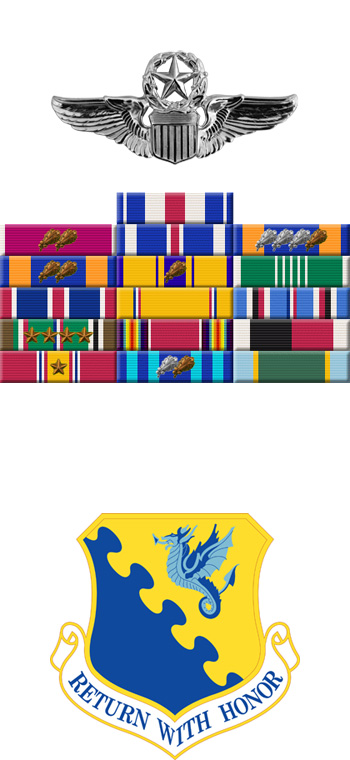
|
Frank A. Hill |
 |
|||
| Rank, Service | ||||
Colonel O-6, U.S. Air Force |
||||
| Veteran of: | ||||
|
||||
| Tribute: | ||||
Frank Hill was born on March 20, 1919, in Nyack, New York. He enlisted in the U.S. Army Reserve on August 12, 1939, and entered the Aviation Cadet Program of the U.S. Army Air Corps on March 14, 1940. Hill was commissioned a 2d Lt and awarded his pilot wings at Kelly Field, Texas, on November 16, 1940, and was then assigned to the 31st Pursuit Group at Selfridge Field, Michigan. Lt Hill moved with the group to Baer Field, Indiana, in 1941, and then to England in May 1942, where he was assigned to the 308th Fighter Squadron flying British Spitfire fighters. He was credited with 1 probable aircraft destroyed in aerial combat over Dieppe, France, before the group moved to Algeria in November 1942, to take part in Operation Torch, the Invasion of North Africa. While flying in the Mediterranean Theater, Hill was credited with destroying 7 enemy aircraft in aerial combat plus 1 more probable and 5 damaged. Maj Hill was commander of the 308th Fighter Squadron from February to March 1943, and then commander of the 309th Fighter Squadron from May to July 1943. He then served as commander of the 31st Fighter Group from July to September 1943, before returning to the U.S. in October 1943. He served as deputy group commander of the 327th Fighter Group at Richmond, Virginia, from October 1943 to April 1944, and then as deputy base commander there until April 1945. Hill then served as deputy base commander at Shaw Field, South Carolina, from April to July 1945, followed by service as base commander of Andrews Field, Maryland, from July to November 1945. He served at Mitchel Field, New York, from November 1945 to January 1946, and then at Shaw Field until July 1947. Col Hill then received an Air Force Institute of Technology assignment to the University of Denver before serving as an Air Force advisor to the New York Air National Guard from August 1949 to May 1951. He served with Headquarters U.S. Air Forces in Europe and on the staff of 12th Air Force from May 1951 to September 1953, and then as commander of the 48th Fighter-Bomber Group at Chaumont-Semoutiers AB in France from September 1953 to July 1954. He attended Army War College from August 1954 to June 1955, and then served with Headquarters U.S. Air Force in the Pentagon from July 1955 to July 1959. Col Hill commanded the 52nd Fighter Group at Suffolk County AFB, New York, from July 1959 to August 1961, and then served as commander of the 4683rd Air Defense Wing at Thule AB, Greenland, from August 1961 to July 1962. His next assignment was as vice commander and then commander of the 64th Air Division at Stewart AFB, New York, from July 1962 to July 1963, followed by service as assistant chief of staff of the 26th Air Division at Stewart until August 1964. He served on the staff with Headquarters Air Defense Command at Ent AFB, Colorado, from August 1964 to June 1967, and then commanded the 33rd Air Division at Fort Lee AFS, Virginia, from June 1967 until his retirement from the Air Force on August 29, 1969. Frank Hill died on January 5, 2012, and was buried at Pompton Plains Reformed Church Cemetery in Pompton Plains, New Jersey. |
||||
|
||||

